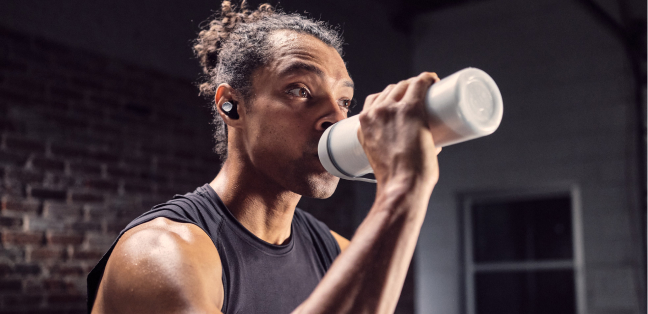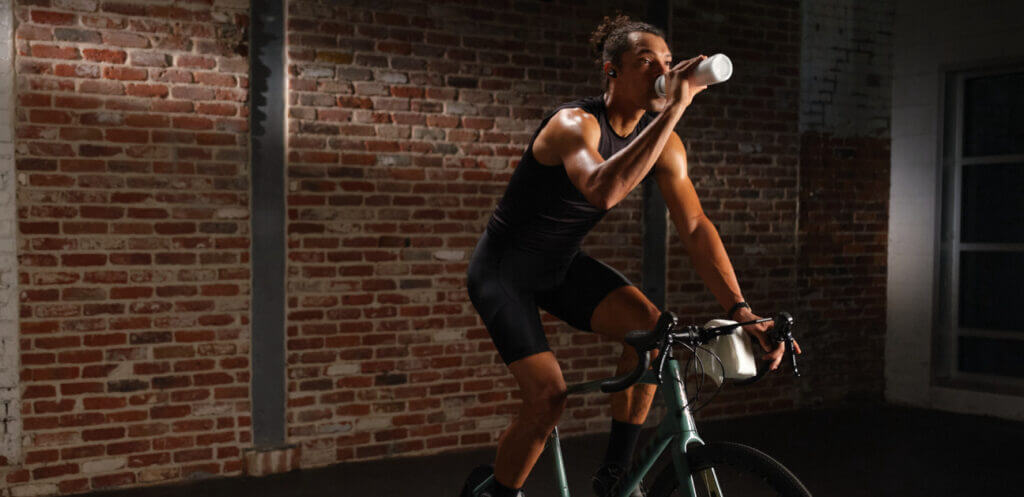How to Choose the Best Mid-Ride Nutrition

The longer and more intense a training session is, the more crucial your mid-ride nutrition becomes. Knowing when to consume liquids, gels, and solids can help you make an on-the-bike nutrition plan that includes the best fuels for you and your ride.
For more information on carbs and cycling, check out Ask A Cycling Coach Ep 310
Key Takeaways
- You can use liquids, gels, and solids to stay fueled during a ride.
- The intensity of your workout affects digestion and absorption.
- On high-intensity rides stick to carbs that are simple and easy to absorb.
- Low-intensity rides offer more opportunities for solids and complex carbs.
- You can prevent palate fatigue on a long ride with a variety of solid foods.
Eating and Drinking on the Bike
Fueling every workout is important, but when a ride is longer than an hour or more intense than a tempo workout, you’ll want to make sure you have an on-the-bike nutrition plan. A mid-ride nutrition plan guarantees that you have enough fuel to maintain your desired energy output and support your body’s increased demand for fuel for the entire ride.
Consuming carbohydrates on the bike is the best way to stay fueled during a ride because it’s the body’s preferred fuel source. For rides lasting longer than an hour, you should try to take in a minimum of 60-90g of carbohydrates per hour. If you’ve practiced consuming carbs on the bike, you might be able to take on more. Research suggests that upwards of 140g per hour can be absorbed through a 1:1 ratio of fructose to glucose. When it comes time to consume these carbohydrates, you have plenty of options.
Types of Fuel
Carbs come in many forms, all with different rates of absorption, unique advantages, and limitations. Typically, mid-ride fuel falls into one of three primary categories to meet your caloric needs—liquids, gels, and solid fuels. During a ride, you may only use one or a combination of all three. What type of fuel you use will vary depending on the workout and how different types of nutrition sit with you.
Liquids
Consuming carbs through your hydration is an easy and sure way to take on the additional calories you need during a ride. For the most part calories in liquid form are effortless to take in, hard to forget, and quick to work. With a wide variety of options, you have the flexibility to decide exactly what goes in your bottle and what flavors you prefer most.
While liquid fuel can be all you need on some rides, most athletes find that they want something a bit more substantial on longer rides. When you’re planning for a longer ride you’ll likely need to integrate an additional source of carbohydrate into the day. When this happens, gels are a great fuel to turn to next.
Gels
The easiest and perhaps most efficient way to consume numerous calories at once is with gels. Energy gels are a quick form of fuel, usually containing a high concentration of carbohydrates, sugars, and sometimes caffeine. They’re easy to eat on the move, and paired with a water bottle containing drink mix, they can be all that you need for the majority of your training rides and races. With that said, many athletes find that there’s a limit to how many gels they can stomach in a given ride. Other times, when athletes are dealing with feelings of hunger they need something more solid.
Solids
Solids can be anything from typical cycling fuels like energy bars and blocks to “normal” foods like fruits and baked goods. When you’re going on a long training ride, or ultra-distance events, integrating solid food into the nutrition plan can be a welcome way to diversify your intake. Variety helps ensure you don’t get too sick of drink mix and gels and that you’re continuing to eat throughout the day.
There is more potential for error when you introduce solid foods onto the bike. Solid foods are the toughest to digest and slower energy sources—making them tougher to time during a workout. Generally, they don’t sit as well during intense exercise, and in some cases, they can cause gastrointestinal distress. What, when, and how much you eat is key to integrating solid foods into your plan.
Key Nutrition Resources
Planning Your Mid-Ride Nutrition
Ultimately, there’s a time and place for all three types of fuel. Some rides might require you to use all three, while on others, one can be plenty. In a similar sense, some kinds of fuel won’t agree with certain workouts. You can use the intensity and duration of the ride to decide what type of fuel will complement its structure and demands.
Intensity and GI Distress
Intensity is one of the most important factors to consider when planning for your ride. For most athletes, tolerance for solid and more complex foods decreases as the intensity goes up. Generally, solid foods are already tougher to digest. During intense exercise, your body is allocating blood and additional resources to other bodily systems, which causes the body to slow digestion. If you consume something solid, it might not digest quickly enough to be a useful resource.
For intense efforts and races, it’s best to stick to quick-acting nutrients like liquids, gels, and simple solids like energy blocks. If you’re planning an intense effort less than three hours, expect to use these fuels and plan accordingly so that the summation of your fuel hits the hourly carbohydrate intake mark. Most athletes can reach their carbohydrate goal with one bottle of high-carb mix and a gel per hour.
If you’re doing a low-intensity ride, you may benefit from integrating some more complex carbs into your nutrition plan. That doesn’t necessarily give you a pass at everything. Anything that’s acidic or has a lot of fiber is more likely to cause GI distress than aid your training. Simple foods that offer variety in taste, like baked goods, are great options.
Duration and Palate Fatigue
What you choose to bring will be similarly affected by the duration of the ride. As the duration of a ride increases, your demand for variety in on-the-bike fuel will likely increase. For example, you can probably stick to gels and liquids without any problem during two hours of low intensity. But if you’re looking to complete a six-hour endurance ride, you might want some more complex carbohydrates on board to help avoid palate fatigue.
Your palate is your general sense of taste and flavor. While gels and drink mix might taste pretty good for a few hours, it’s normal to experience a little palate fatigue when you’re faced with numerous hours of gels and drink mix. As your rides get longer and you continue to take in fuel like gels, blocks, and drink mix, your ability to stomach highly processed fuels might deteriorate. Palate fatigue is a problem if you’re going to reach a point in the ride where you’ll stop taking in fuel.
Adaptive Training
Get the right workout, every time with training that adapts to you.
Check Out TrainerRoadWith that said, palate fatigue isn’t an issue for everyone. Some athletes can take on bars, blocks, and gels for hours with no problem. Furthermore, like anything, most athletes can train themselves to sustain on gels and drink mix. With that said, there’s no point in ignoring something you know about yourself. If you know you’re going to hit a wall you should plan accordingly and bring some good solid food options. It’s better to plan ahead and anticipate a potential problem than to stick to a plan you know you can’t maintain and risk skipping your fuel.
What Works for You?
As is with any nutrition, you don’t know what works for you until you test it out in training. Furthermore, your body needs time to adapt to anything new that you decide to introduce. Use your training sessions to experiment with different nutrition strategies and try new types of fuels. When you’ve familiarized yourself with what works for you and what doesn’t, you can solidify your mid-ride nutrition plan. Eventually, your fueling strategy will become second nature, and you won’t have to think twice about what fuel you need to be successful.
